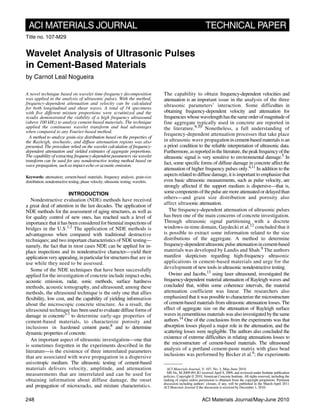Contenu connexe
Similaire à 477de38f48f26b1f18a65907c7b8e1d9.pdf
Similaire à 477de38f48f26b1f18a65907c7b8e1d9.pdf (20)
477de38f48f26b1f18a65907c7b8e1d9.pdf
- 1. 248 ACI Materials Journal/May-June 2010
ACI MATERIALS JOURNAL TECHNICAL PAPER
ACI Materials Journal, V. 107, No. 3, May-June 2010.
MS No. M-2009-091.R1 received April 8, 2009, and reviewed under Institute publication
policies. Copyright © 2010, American Concrete Institute. All rights reserved, including the
making of copies unless permission is obtained from the copyright proprietors. Pertinent
discussion including authors’ closure, if any, will be published in the March-April 2011
ACI Materials Journal if the discussion is received by December 1, 2010.
A novel technique based on wavelet time-frequency decomposition
was applied in the analysis of ultrasonic pulses. With the method,
frequency-dependent attenuation and velocity can be calculated
for both longitudinal and shear waves. A total of 14 specimens
with five different mixture proportions were scrutinized and the
results demonstrated the viability of a high frequency ultrasound
(above 100 kHz) to analyze cement-based materials. The technique
applied the continuous wavelet transform and had advantages
when compared to any Fourier-based method.
A method to analyze grain-size distribution based on the properties of
the Rayleigh, stochastic, and diffuse attenuation regions was also
presented. The procedure relied on the wavelet calculation of frequency-
dependent attenuation and yielded estimates of aggregate proportions.
The capability of extracting frequency-dependent parameters via wavelet
transform can be used for any nondestructive testing method based on
wave propagation, such as impact-echo or acoustic emission.
Keywords: attenuation; cement-based materials; frequency analysis; grain-size
distribution; nondestructive testing; phase velocity; ultrasonic testing; wavelets.
INTRODUCTION
Nondestructive evaluation (NDE) methods have received
a great deal of attention in the last decades. The application of
NDE methods for the assessment of aging structures, as well as
for quality control of new ones, has reached such a level of
importance that it has been considered for biennial inspections of
bridges in the U.S.1,2
The application of NDE methods is
advantageous when compared with traditional destructive
techniques; and two important characteristics of NDE testing—
namely, the fact that in most cases NDE can be applied for in-
place inspections and its nondestructive character—yield their
applicationveryappealing,inparticularforstructuresthat are in
use while they need to be assessed.
Some of the NDE techniques that have been successfully
applied for the investigation of concrete include impact-echo,
acoustic emission, radar, sonic methods, surface hardness
methods, acoustic tomography, and ultrasound; among these
methods, the ultrasound technique is the only one that allies
flexibility, low cost, and the capability of yielding information
about the microscopic concrete structure. As a result, the
ultrasound technique has been used to evaluate diffuse forms of
damage in concrete3-7
to determine early-age properties of
cement-based materials, to characterize porosity and
inclusions in hardened cement paste,8
and to determine
dynamic properties of concrete.
An important aspect of ultrasonic investigation—one that
is sometimes forgotten in the experiments described in the
literature—is the existence of three interrelated parameters
that are associated with wave propagation in a dispersive
anisotropic medium. The ultrasonic testing of cement-based
materials delivers velocity, amplitude, and attenuation
measurements that are interrelated and can be used for
obtaining information about diffuse damage, the onset
and propagation of microcracks, and mixture characteristics.
The capability to obtain frequency-dependent velocities and
attenuation is an important issue in the analysis of the three
ultrasonic parameters’ interaction. Some difficulties in
obtaining frequency-dependent velocity and attenuation for
frequencieswhosewavelengthhasthesameorderofmagnitudeof
fine aggregate typically used in concrete are reported in
the literature.9,10
Nonetheless, a full understanding of
frequency-dependent attenuation processes that take place
in ultrasonic wave propagationincement-basedmaterialsisan
a priori condition to the reliable interpretation of ultrasonic data.
Furthermore,asreportedintheliterature,thepeakfrequencyofthe
ultrasonic signal is very sensitive to environmental damage.5
In
fact, some specific forms of diffuse damage in concrete affect the
attenuation of higher frequency pulses only.4,11
In addition to the
aspects related to diffuse damage, it is important to emphasize that
even basic ultrasonic measurements, such as pulse velocity, are
strongly affected if the support medium is dispersive—that is,
somecomponentsofthepulsearemoreattenuatedordelayedthan
others—and grain size distribution and porosity also
affect ultrasonic attenuation.
The frequency-dependent attenuation of ultrasonic pulses
has been one of the main concerns of concrete investigation.
Through ultrasonic signal partitioning with a discrete
windows-in-time domain, Gaydecki et al.12
concluded that it
is possible to extract some information related to the size
distributions of the aggregate. A method to determine
frequency-dependentultrasonicpulseattenuationincement-based
materials was developed by Landis and Shah.9
The authors
manifest skepticism regarding high-frequency ultrasonic
applications in cement-based materials and urge for the
development of new tools in ultrasonic nondestructive testing.
Owino and Jacobs,13
using laser ultrasound, investigated the
frequency-dependent material attenuation of Rayleigh waves and
concluded that, within some coherence intervals, the material
attenuation coefficient was linear. The researchers also
emphasized that it was possible to characterize the microstructure
of cement-based materials from ultrasonic attenuation losses. The
effect of aggregate size on the attenuation of Rayleigh surface
wavesincementitiousmaterialswasalsoinvestigatedbythesame
authors.14
One of the conclusions from the experiments was that
absorption losses played a major role in the attenuation, and the
scattering losses were negligible. The authors also concluded the
existence of extreme difficulties in relating attenuations losses to
the microstructure of cement-based materials. The ultrasound
analysis of a portland cement-paste matrix with glass bead
inclusions was performed by Becker et al.6
; the experiments
Title no. 107-M29
Wavelet Analysis of Ultrasonic Pulses
in Cement-Based Materials
by Carnot Leal Nogueira
